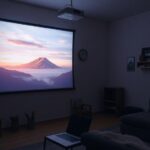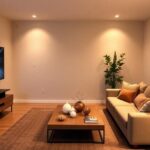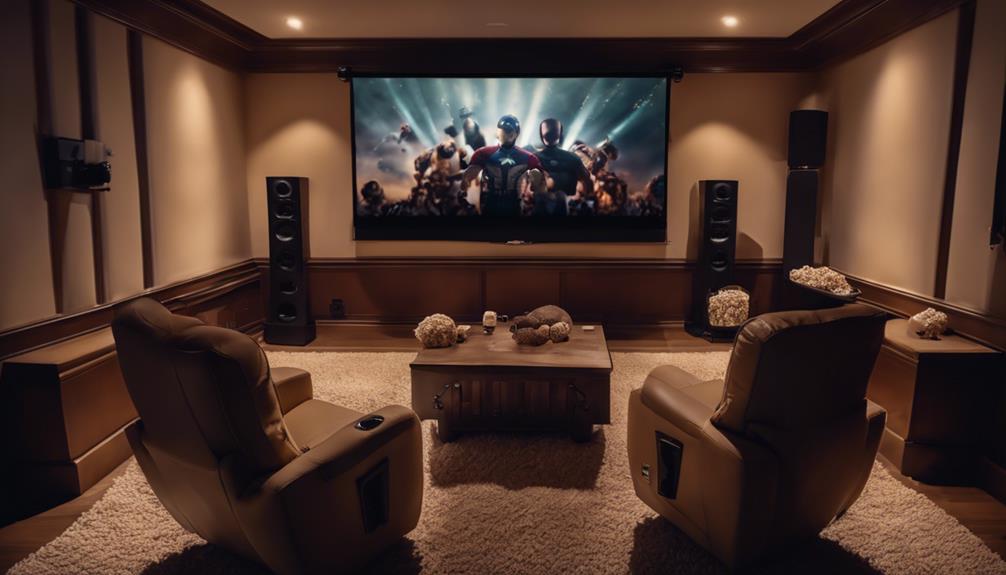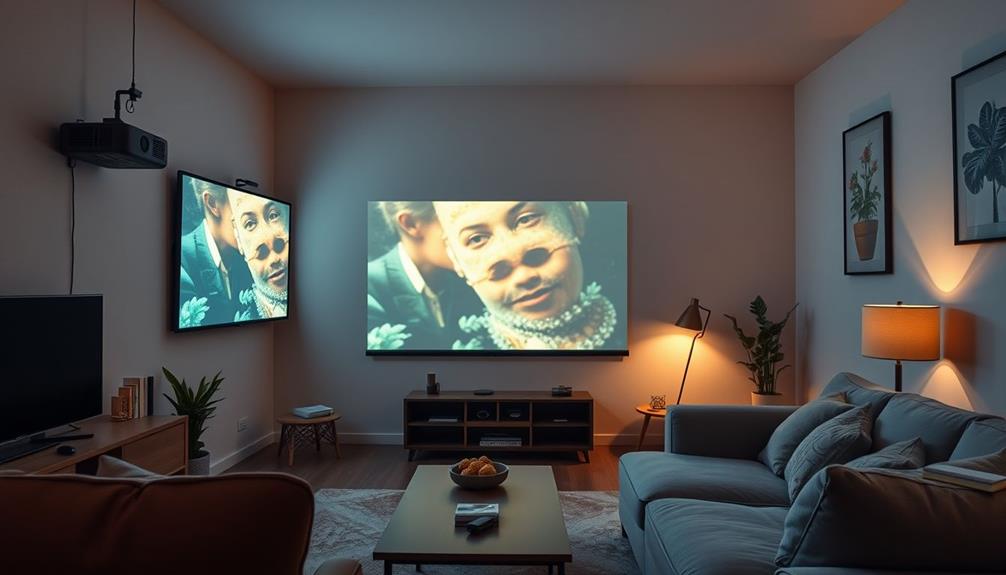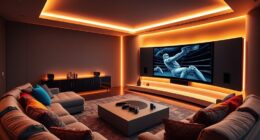Using a projector for video conferencing boosts clarity and engagement greatly. To guarantee clear communication, position the projector 1.5 to 2 times the screen's width away and adjust it to eye level. Choose a projector with at least 3000 lumens for brightness, and use a matte finish screen to reduce glare. For ideal sound, employ high-quality microphones and minimize background noise with soft furnishings. Arrange seating in a semicircle to enhance interaction, and opt for soothing colors in your room to maintain focus. Stick around to uncover more effective strategies for successful video conferencing setups.
Key Takeaways
- Position the projector at eye level and maintain a distance of 1.5 to 2.5 times the screen width for optimal visibility and clarity.
- Utilize high-quality microphones and echo cancellation technology to enhance audio clarity and minimize background noise during video conferencing.
- Choose a matte finish screen to reduce reflections and ensure sharp, clear images for all participants.
- Employ calming, solid color backgrounds to improve video clarity and reduce distractions for remote attendees.
- Encourage engagement by incorporating interactive features like polls and shared documents during the presentation.
Importance of Projectors in Meetings
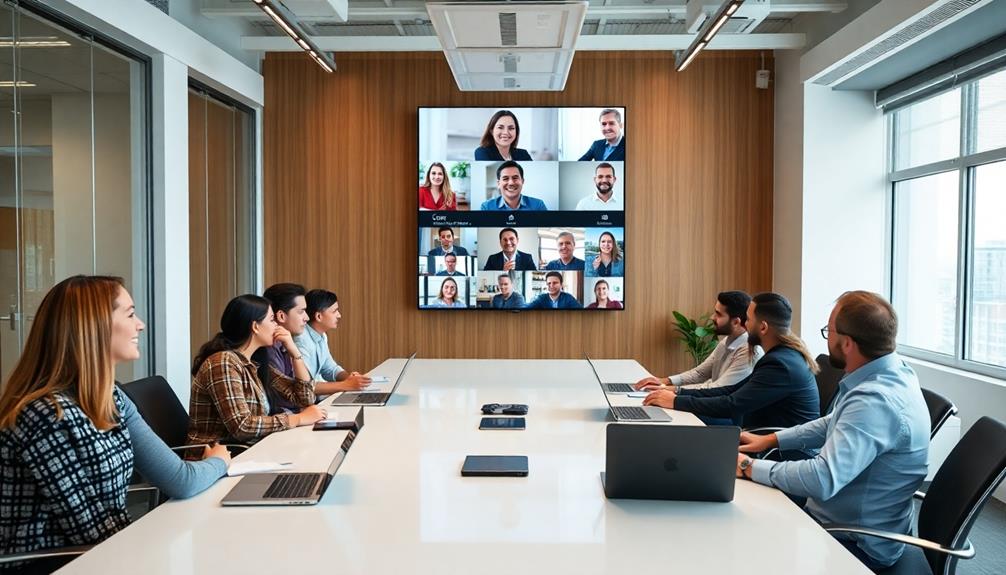
Why are projectors essential in meetings? In today's fast-paced business environment, projectors play an important role in enhancing communication and collaboration. They greatly improve the visibility of presentations, making it easier for everyone to engage with visual content. This is especially important during remote meetings, where effective communication can make or break a discussion.
Additionally, the role of color accuracy in projectors guarantees that the visuals aren't only visible but also vibrant and true to life, which can greatly impact the effectiveness of your message.
Modern projectors in business support various multimedia formats, allowing you to incorporate videos, images, and interactive elements into your presentations. This dynamic approach fosters participant engagement and keeps attention focused.
Plus, many projectors come equipped with features that guarantee clear audio, such as echo cancellation. This reduces disruptive background noise and allows your voice to come through clearly, enhancing the overall meeting experience.
The portability of modern projectors also adds value, enabling quick shifts between different locations and setups. This flexibility helps streamline your meetings, making sure that you can focus on what really matters—collaboration and communication.
Room Design and Layout Tips
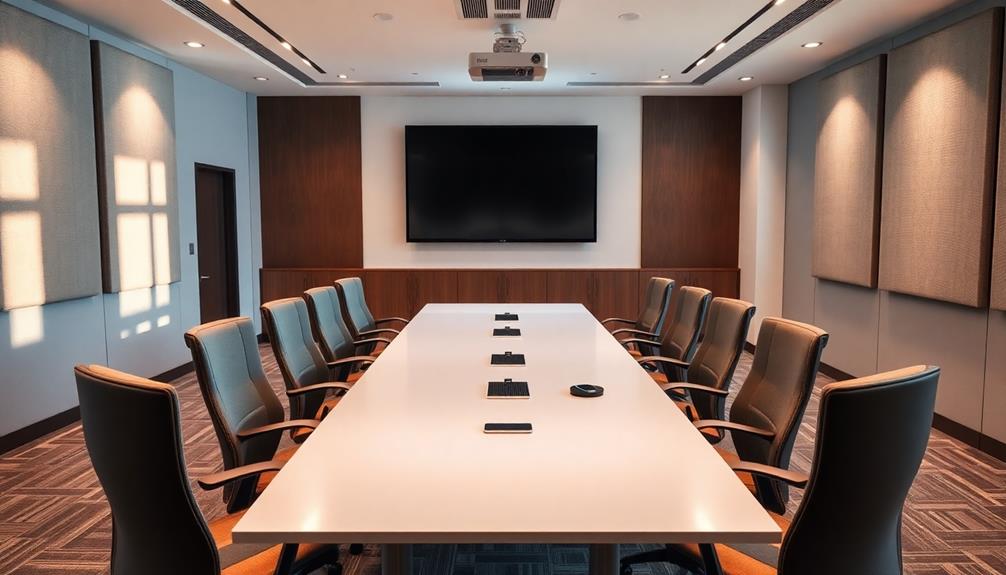
When designing your room for video conferencing, focus on ideal seating arrangements and background color choices.
Consider incorporating elements that enhance sound quality and minimize echo, such as maximizing space and layout optimization with soft furnishings or wall treatments.
Use muted tones like warm beige or grey to keep distractions at bay, and arrange seats in a circular or U-shape to enhance visibility and engagement.
This setup not only helps everyone connect visually but also creates a more inviting atmosphere for discussions.
Optimal Seating Arrangement
Creating an inviting and functional space for video conferencing starts with the right seating arrangement. Aim for an ideal seating arrangement that fosters effective communication among all participants. Arrange seats in a semicircle or U-shape, making sure everyone has a clear view of the projector screen while maintaining eye contact with each other. Incorporating technology such as Intelligent Tutoring Systems (ITS) can further enhance engagement during discussions.
Position the seats at a distance of 1.5 to 2 times the screen height. This distance enhances visibility and comfort during presentations, making it easier for both in-person and remote participants to engage. Be mindful of sightlines; avoid blocking views of the projector to guarantee that everyone can see the shared content clearly, regardless of their seating position.
If your room size allows, consider tiered seating or raised platforms to prevent obstructed views for attendees seated behind others. Design the seating to facilitate easy movement and communication, allowing all participants to interact without disrupting the flow of the meeting.
Background and Color Choices
To set the right tone for your video conferencing space, choosing the right background and color scheme is essential. Start by selecting calming colors like blue, grey, or warm beige. These shades not only create a soothing atmosphere but also help reduce distractions from background noise. Avoid pure black or white, as they can detract from video clarity and create harsh contrasts.
Using muted colors in your background will enhance video clarity, ensuring that your participants stand out without visual interference. Opt for solid color backgrounds instead of patterns; stripes and checks can distract viewers during calls.
Here's a quick reference table to help you choose:
| Color Choice | Benefits |
|---|---|
| Blue | Calming effect |
| Grey | Reduces distractions |
| Warm Beige | Inviting atmosphere |
Make sure your seating arrangement allows all participants to be visible to the camera. This way, everyone can engage directly with remote attendees, fostering clearer communication. By implementing these background and color choices, you'll create a professional environment that enhances your video conferencing experience.
Optimal Projector Positioning
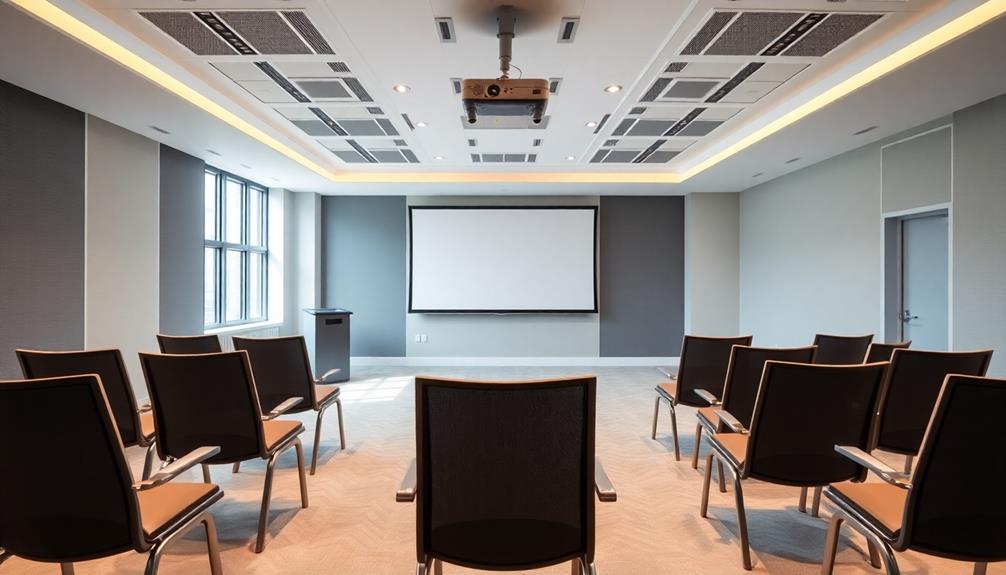
When you're setting up your projector, consider the ideal distance from the screen to guarantee a sharp image.
You also need to adjust the height and angle to keep the projected content clear and avoid shadows or glare.
Getting these factors right will enhance the overall video conferencing experience for everyone involved.
Ideal Distance From Screen
Finding the right distance from the screen for your projector is essential for a great video conferencing experience. The ideal distance from the screen typically ranges from 1.5 to 2.5 times the width of the screen. For a standard 100-inch screen, this means your projector placement should be approximately 8 to 12.5 feet away.
By adjusting the projector position within this range, you'll achieve excellent image clarity, ensuring that your visuals are sharp and free from distortion. This distance also helps maintain the recommended screen height, ideally aligning the center of the image at eye level for all viewers.
Additionally, keeping the projector within this excellent distance minimizes the risk of casting shadows, which can disrupt visibility during video conferencing.
Make sure the projector is positioned perpendicular to the screen as well; this helps prevent keystone distortion, preserving the image quality and clarity.
Height and Angle Adjustment
Getting the height and angle right for your projector is essential for a seamless video conferencing experience. Position the projector at eye level to align the projected image with participants' sightlines. This minimizes neck strain and keeps everyone engaged.
For clear communication, confirm the projector is perpendicular to the screen surface. This prevents keystoning, which can distort the image and lead to misunderstandings.
You should maintain a distance of 1.5 to 2 times the width of the projected image from the screen. This helps achieve ideal clarity and brightness, making your content easier to see and understand.
To facilitate effective height and angle adjustment, utilize adjustable projector mounts or stands. These allow you to modify the projector's position quickly, accommodating different room layouts or seating arrangements.
Regularly check and calibrate your projector's focus and alignment. This confirms you provide clear, sharp images that enhance the video conferencing experience.
With the right height and angle adjustments, you'll set the stage for better collaboration and communication, helping everyone stay on the same page during your meeting.
Avoiding Shadows and Glare
To avoid shadows and glare during video conferencing, position your projector carefully to enhance visibility for all participants.
You'll want to make sure your projector is aligned with the screen's height, ideally slightly above or below eye level, to minimize shadows cast by participants. Additionally, place the projector at least 1.5 times the width of the screen away to reduce glare from room lighting.
Here are some tips to further improve your setup:
- Avoid positioning the projector directly in front of participants to prevent obstructing their view.
- Use soft, diffuse lighting in the room to minimize harsh shadows and glare on both the screen and participants' faces.
- Choose a projector with a high lumen count (at least 3000 lumens) for bright, clear images that resist ambient light interference.
- Regularly adjust the projector angle as needed to maintain ideal visibility throughout the conference.
- Consider using a screen with a matte finish to reduce reflections and enhance image quality.
Enhancing Audio Quality
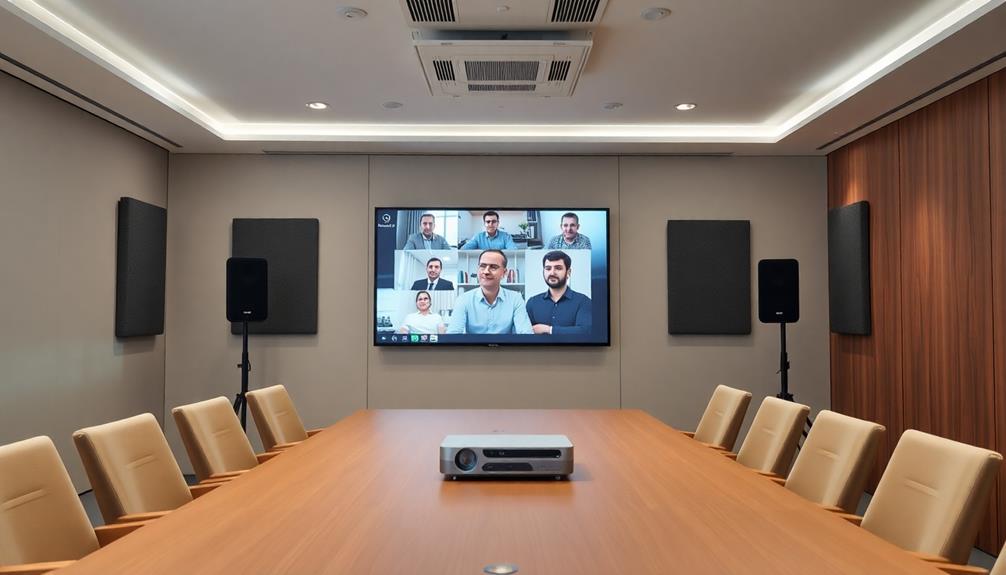
Enhancing audio quality during video conferencing is vital for effective communication and collaboration. To achieve this, start by using high-quality microphones strategically placed to capture sound from all participants. Ideally, position the microphones at a distance of five times the distance from the speaker to guarantee clarity.
Implement echo cancellation technology to minimize disruptive echoes, which is important in busy office environments where background noise can interfere with conversations.
Choose a low-noise room for your video conferencing. This setting will reduce reverberation and background distractions, greatly improving audio clarity. For group settings, sensitive, floor-standing microphones work best, making sure that all speakers are captured effectively, regardless of their position in the room.
Don't forget to maintain a consistent audio level. Adjust the volume settings based on the room size and the number of participants. This way, everyone can hear and engage without straining, enhancing the overall audio quality of your meeting.
Engaging Participants Effectively
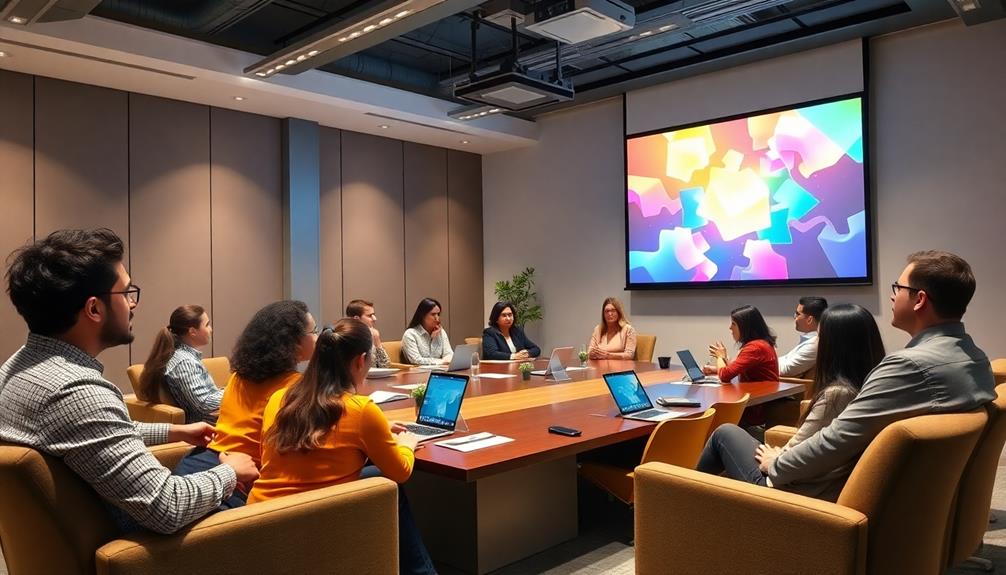
Effective engagement of participants is key to a successful video conference. Using a projector can enhance this engagement, ensuring remote attendees feel included and connected.
Here are some strategies to keep everyone involved:
- Position the projector for ideal visibility, ensuring everyone can see and engage without straining.
- Use high-quality audio and video equipment to make sure remote voices are clear and distinct.
- Incorporate interactive features like polls or shared documents, displayed via the projector, to foster active participation.
- Encourage real-time note-taking on projected content, allowing participants to contribute ideas and keep aligned with the agenda.
- Facilitate discussion by inviting input from remote attendees, ensuring they feel heard and valued.
Best Practices for Video Conferencing

When planning a video conference, maintaining a professional atmosphere is vital for productivity and engagement. Start by guaranteeing a stable internet connection, aiming for at least 1.5 Mbps upload/download speed. High-quality audio and video equipment, such as external microphones and HD cameras, can greatly enhance clarity and reduce background noise.
Familiarize yourself with the video conferencing tools available, like screen sharing and breakout rooms, to maximize interaction among participants. A well-set conference room also plays an essential role; confirm your background is professional and the lighting is ideal. Position soft, diffuse light in front of you to avoid harsh shadows.
Encouraging active engagement can boost participation. Utilize interactive features like polls and chat options to create a more dynamic environment.
| Tip | Description | Benefit |
|---|---|---|
| Stable Internet | At least 1.5 Mbps upload/download speed | Clear audio/video |
| Quality Equipment | Use HD cameras & external mics | Enhanced clarity |
| Familiarize Tools | Learn features like screen sharing | Increased engagement |
| Professional Setup | Ideal lighting & background | Improved professionalism |
Frequently Asked Questions
What Are the Do's and Don'ts of Video Conferencing?
When video conferencing, make certain you've tested your equipment and set up proper lighting. Keep backgrounds simple, maintain clear audio, and engage with participants. Avoid distractions to guarantee everyone stays focused on the discussion.
How Does Video Conferencing Improve Communication?
"Actions speak louder than words." Video conferencing boosts communication by allowing you to see facial expressions and body language, enhancing understanding and engagement. It fosters collaboration, speeding up decision-making and improving information retention considerably.
How to Have a Hybrid Meeting That Works for Everyone?
To have a successful hybrid meeting, position your projector for visibility, use quality audio systems, share a clear agenda in advance, encourage participation with interactive tools, and check technology beforehand to guarantee everything runs smoothly.
How to Set up a Computer for Video Conference?
Setting up your computer for a video conference can feel like preparing for a rocket launch! Connect your webcam and mic, adjust display settings, and test everything to guarantee a smooth, distraction-free experience.
Conclusion
In the world of video conferencing, your projector is like a lighthouse guiding ships through foggy waters. It illuminates your ideas, ensuring everyone's on the same page. By fine-tuning your room layout, positioning your projector correctly, and enhancing audio quality, you're paving the way for clear communication. So, as you engage your participants, remember: a well-lit discussion sparks creativity and collaboration, transforming your meetings into vibrant exchanges where every voice shines bright.
Hi, I’m Dominique. I love movies and want everyone to have the best home cinema experience possible. That’s why I started 1home Theatre Projector. We help people build their home cinema system using the latest technology and news on laser tv and all-around home entertainment.
We’re a small team of movie buffs (and experts) who are passionate about giving our readers the best advice and information possible. So whether you’re just starting out or you’re looking to upgrade your home cinema system, we’ve got you covered!





